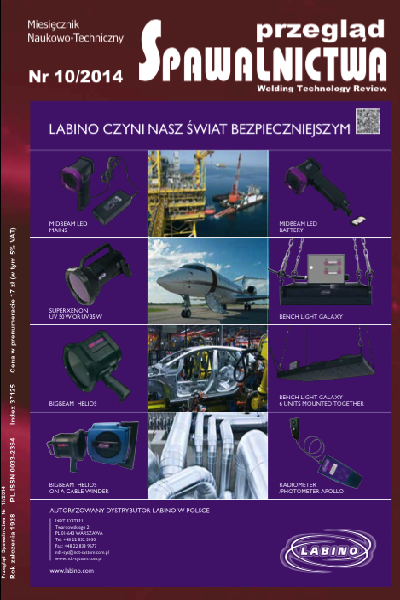Detekcja wad squat w szynach kolejowych; Detection of squat defects in railway
Main Article Content
Abstract
Stan toru kolejowego ma istotny wpływ na bezpieczeństwo ruchu kolejowego. Do tej pory na PKP stan toru był diagnozowany wyłącznie na podstawie badań ultradźwiękowych. Pozwala to na wykrywanie wad znajdujących się wewnątrz szyny. Metoda ta jest jednak zawodna, gdy wady znajdują się na powierzchni szyny lub bezpośrednio pod jej powierzchnią. wady typu squat należą do grupy wad, które nie mogą być wykryte tradycyjną metodą ultradźwiękową. Skłoniło to autora do opracowania wizyjnych algorytmów detekcji tego typu wad. wykorzystano do tego celu bank filtrów Gabora. w celu określenia najbardziej istotnych cech opisujących te wady wykorzystano technikę selekcji cech zależnych od rodzaju klasyfikatora. Klasyfikacja (detekcja) wad przeprowadzona została wg klasyfikatora SVM. Uzyskano 94% skuteczność klasyfikacji.
Abstract
The state of the railway track has a significant impact on the safety of railway traffic. It is an important topic at the time of a steady increase in speed and the load of railway lines. Until now, the state of rails of the Polish Railway Lines has been verified exclusively by the ultrasonic method. It makes it possible to detect flaws occurring in the cross-section of the rail head. Unfortunately, it is useless when surface flaws are located on or a few millimeters beneath the surface of the rail head. Squat flaws belong to the group of flaws which are not detected by traditional methods. It has led the author to develop and verify algorithms allowing for automatic visual detection of squat flaws. A bank of Gabor filters was used to detect these flaws. In order to select the most informative features describing the squats, sequential feature selection methods based on the wrapper technique were used. Discrimination among areas with squat and areas without squat is performed. by an SVM (Support Vector Machine) classifier. In the case of this method, the detection rate was 94%.
Downloads
Article Details
Creative Commons CC BY 4.0 https://creativecommons.org/licenses/by/4.0/
Welding Technology Review (WTR) articles are published open access under a CC BY licence (Creative Commons Attribution 4.0 International licence). The CC BY licence is the most open licence available and considered the industry 'gold standard' for open access; it is also preferred by many funders. This licence allows readers to copy and redistribute the material in any medium or format, and to alter, transform, or build upon the material, including for commercial use, providing the original author is credited.
References
I. Elshafiey, L. Lalita Udpa.: A new eddy current imaging sys- tem for enhancement of nondestructive evaluation; NDT.net, Vol. 9, 2004, Internet http://www.ndt.net/article/mendt03/el- shaf/elshaf.htm
M. Migdal: Istotne czynniki warunkujące wybór strategii szlifowania szyn; VI Konferencja Naukowo-Techniczna InFRASZYN, 2013.
P. Bojarczak : Visual algorithms for automatic detection of squat flaws in railway rails; Insight Non-Destructive Testing and Condition Monitoring, The Journal of The British Institute of Non-Destrictive Testing. Vol. 6 July, 2013.
K. Jain, n. Ratha, S. Lakshmanan: Object detection using Gabor Filter; Pattern Recognition. Vol. 30, no. 2, (295-309), 1997.
A. Kumar, GKH. Pang: Defect detection in textured materials using Gabor filters; IEEE Transactions on Industry Applications, Vol. 38, no. 2, (425-440), 2002.
C. Mandriota, M. nitti, n. Ancona, A. Distante: Filter-based feature selection for rail defect detection; Machine Vision and Application, Springer, Vol.15, (179-185), 2004.
J.K. Kamarainen: Feature Extraction using Gabor filters; PhD dissertation, Lappeenranta University of Technology, Finland, 2003.
Y. Rubner, C. Tomasi: Perceptual metrics for image database navigation; Kluwer Academic Publishers 2004.
I. Guyon, J. Weston, S. Barnhill, V. Vapnik: Gene selection for cancer classification using Support Vector Machines; Machine Learning, Kluwer Academic Publishers, (389-422), 2002.
Y. Saeys, I. Inza, P. Larranaga: A review of feature selection techniques in bioinformatics; Bioinformatics Advance Access, 2007.
B. Scholkopf, A. Smola: Learning with kernels, Support Vector Machines, regularization, optimization and beyond; MIT Press, Cambridge, Massachusetts, London, 2002.
